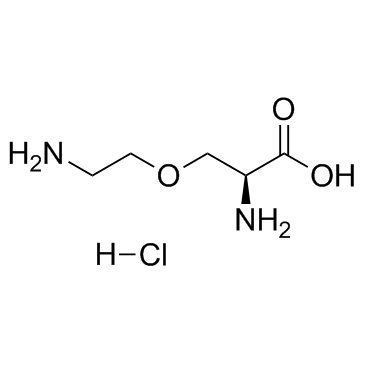L-4-Oxalysine (hydrochloride)
Modify Date: 2024-01-03 11:46:43

L-4-Oxalysine (hydrochloride) structure
|
Common Name | L-4-Oxalysine (hydrochloride) | ||
|---|---|---|---|---|
| CAS Number | 118021-35-5 | Molecular Weight | 184.62100 | |
| Density | N/A | Boiling Point | 359.7ºC at 760mmHg | |
| Molecular Formula | C5H13ClN2O3 | Melting Point | 212-216ºC(lit.) | |
| MSDS | N/A | Flash Point | 171.4ºC | |
Use of L-4-Oxalysine (hydrochloride)L-4-Oxalysine hydrochloride is a natural product isolated from the culture media of Streptomyces roseovirdofuscus in China which has shown antitumor activities. |
| Name | (2S)-2-amino-3-(2-aminoethoxy)propanoic acid,hydrochloride |
|---|---|
| Synonym | More Synonyms |
| Description | L-4-Oxalysine hydrochloride is a natural product isolated from the culture media of Streptomyces roseovirdofuscus in China which has shown antitumor activities. |
|---|---|
| Related Catalog | |
| In Vitro | Alpha-fetoprotein (AFP) is expressed in BEL-7404 human hepatoma cells and L-4-Oxalysine suppresses AFP mRNA expression in the cells[1]. L-4-oxalysine functionally antagonizes the a-fetoprotein-induced suppression of the mitogen- and one-way mixed lymphocyte culture-induced proliferation of spleen lymphocytes and interleukin-6 production by these cells in mice bearing the hepatoma-22 tumor[2]. |
| In Vivo | Tbe ultrastructural efects of different doses of L-4-Oxalysine on hepatocytes in mice are most serious at day 1 after stopping treatment. Mice are given ig L-4-oxalysine (I-677) 10, 50, and 100 mg/kg for 7 d. On day 8 the hepatocytes show accumulation of lipid droplets followed by loss of matrices in cytoplasm. The total area of lipid droplets is far less than 25% of mean section of hepatocytes. The injury of mitochondria and RER is only found in the groups of medium and high dose[1]. L-4-oxalysine inhibits the proliferation of some mouse implanted tumors and pulmonary metastasis of mouse Lewis lung carcinoma[2]. |
| Animal Admin | Mice: Sixty mice are randomly and equally divided into 4 groups. One of the groups is given ig saline and the other are given ig 10, 50, 100 mg /kg for 7d. On day l, 7, 14, and 28 respectively after terminating the treatment, 3 mice of each group are killed and the samples are examined under transmission electron microscope[1]. |
| References |
| Boiling Point | 359.7ºC at 760mmHg |
|---|---|
| Melting Point | 212-216ºC(lit.) |
| Molecular Formula | C5H13ClN2O3 |
| Molecular Weight | 184.62100 |
| Flash Point | 171.4ºC |
| Exact Mass | 184.06100 |
| PSA | 98.57000 |
| LogP | 0.57620 |
| Vapour Pressure | 3.77E-06mmHg at 25°C |
| Hazard Codes | Xi: Irritant; |
|---|---|
| Risk Phrases | R36/37/38 |
| Safety Phrases | S26 |
| WGK Germany | 3 |
| (S)-(+)-2-Amino-3-(2-aminoethoxy)propanoic acid monohydrochloride |
| O-2-aminoethylserine dihydrochloride |
| O-(2-Amino-aethyl)-serin,Dihydrochlorid |
| 4-oxalysine dihydrochloride |
| DL-4-Oxalysine dihydrochloride |
| O-(2-aminoethyl)-l-serine hydrochloride |
| MFCD01631149 |
| L-4-Oxalysine (hydrochloride) |